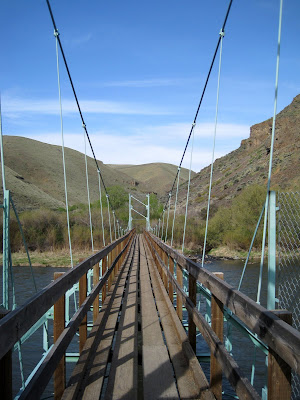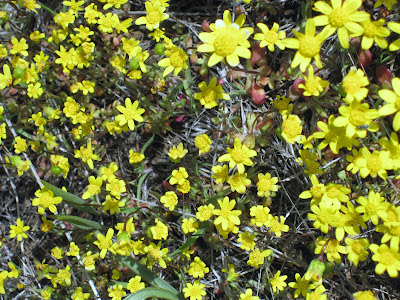I returned to this trail for the first time this year. I heard about it in an article in the Seattle Times and thought it was just perfect for a day away.
Thorp is located at exit 101 on I-90 just west of Ellensberg. Most people know it for the gigantic "fruit" stand. Surrounded by hay fields this is the place where the foothills meet the flats. From here one can strike out into the foothills leading up into the L.T. Murray Wildlife Management Area and the National Forest areas that lead up to the Cascades.
I love the area since the ecology is so dramatically different from my everyday world that if fells like I have gone someplace foreign even though I am well familiar with this backyard.
The canyon roads leading up to the L T Murray are often only walkable. Those with horses have great opportunity to get far up and in. If you have the right road you can often drive up but there can be wash outs and rock fall. These events actually help keep the area wild and clean.
The Ray Westburg is a popular hiking and running trail. Named in memory of a local high school coach it attracts people of all abilities. The climb is moderately steep with great sweeping views of the Kittitas Valley and the Stewart Range. One local told me that it is a popular summer night hike since the horizon is clear to the east, a great place to watch moonrise.
The environment is great. Sage and Rabbit Brush dominate. You get into the dry ecology and are surrounded by plants. Last summer there was a lot of buckwheat in bloom. This was a huge bonus as buckwheat supports a whole population of butterflies who dine on them. It provided a lot of camera fun.
In late June Desert Mariposa Lily are everywhere in the middle third of the trail. They are a beautiful surprise for anyone expecting a lifeless place. You all will have to wait for June to see pictures.
To the west of the trail a re-entrant (short valley) supports pine trees and as you climb you can see into the branches. A few snags are mixed in. Last year I saw a Lewis Woodpecker nest and a group of young Kestrel waiting for their parents.
Sunday I arrived a bit later than I thought I would. Work took longer than I thought it would. I like to get to an area early for the best birds and to beat the heat. I don't know what I was thinking. I knew it would be warm so I brought a short sleeve shirt. I even remembered my water bottle and my car now has its required gallon water jug. so I always have refills.
At the beginning of the trail is a private property. There is a large vegetable garden just getting started and next to that a nice line of cherry trees. It was here that I photographed the House Wren that I use for my avatar.
When you get to the start of the trail proper you find one of the most welcoming sights going, a walking stick rack. People bring and leave stout sticks or even ski poles and leave them for others. This is a trail I would recommend a walking stick for sure. You can see the ecology of the slope andhow it changed from the garden plot.
The way is a good consistent up. There are plenty of reasons to stop and look
flowers...
Yellow bells, the early Spring bloom. Spring is just starting on this slope.

Sagebrush Violets and Gold Star, carpets of them, particularly on the flat top. Another group of flowers that signal Spring.
Daggerpod. These leaves are soft like lambswool.
bugs...
Don't know what these buffy green bugs are, but they are everywhere, here on Spring Beauty.

even an occasional horned toad. They love ants.

and the view.
To my horse buddies, that is Timothy hay yumm
At the top there are some loving memorials to community members. If you ramble on you will find the roads and habitat of the L T Murray. This is an open flat dry spot and it is a bit of a contrast to the ecology of the slope. It is possible to drive in to this spot , but there is something more satisfying about the hike.
You can go down the way you came up or, like I did, detour onto the Boy Scout Trail. This trail cuts left and descends in the next re-entrant. Unlike the open slope of the up trail, this trail goes through pine woods. Right now there is not a lot of plant and flower action in the woods. I did get a nice visit from a Pine Chipmunk and watched a nuthatch excavating a nest hole.

I discovered a new plant along the irrigation channel that returns to the trail head, Columbian Piccoon. It is juicy leaved and packed with flowers. Plus the name is odd, my book mentions no meaning of the name.

bug butt
The round trip can take a few hours if you are a meadering one, like myself, or just an hours or so if you are a runner, like those you might encounter very early in the morning.
My car now needs one more essential for this time of year. Sunscreen. We now need sunscreen.

















.JPG)





































.JPG)

.JPG)